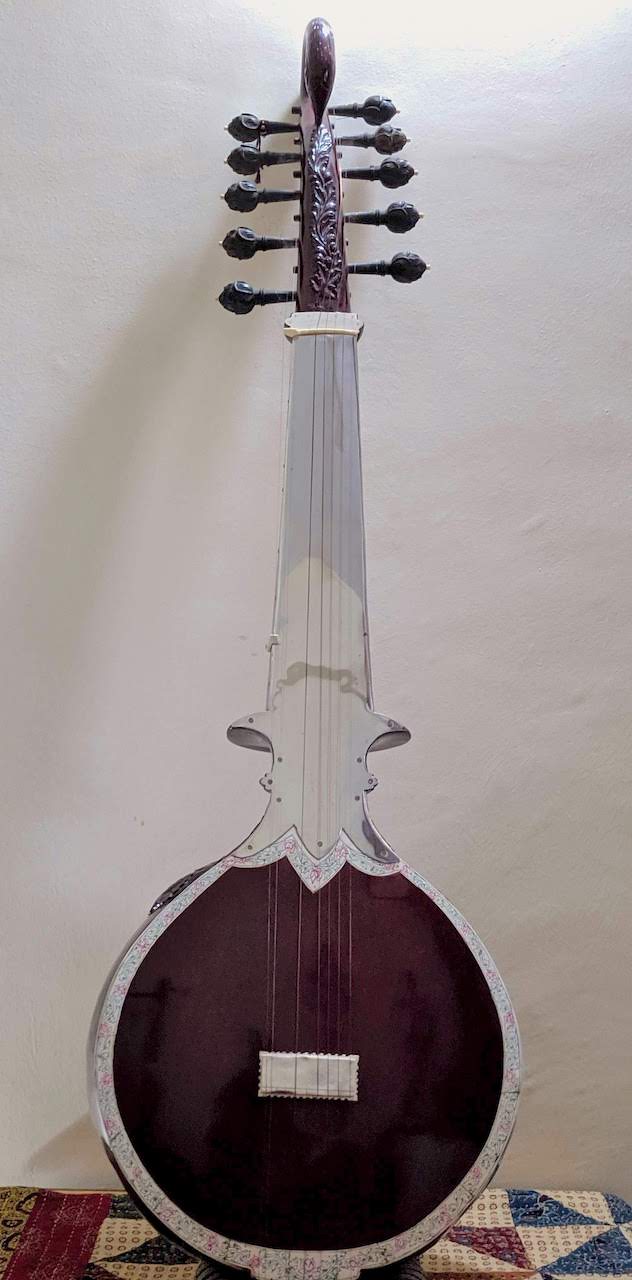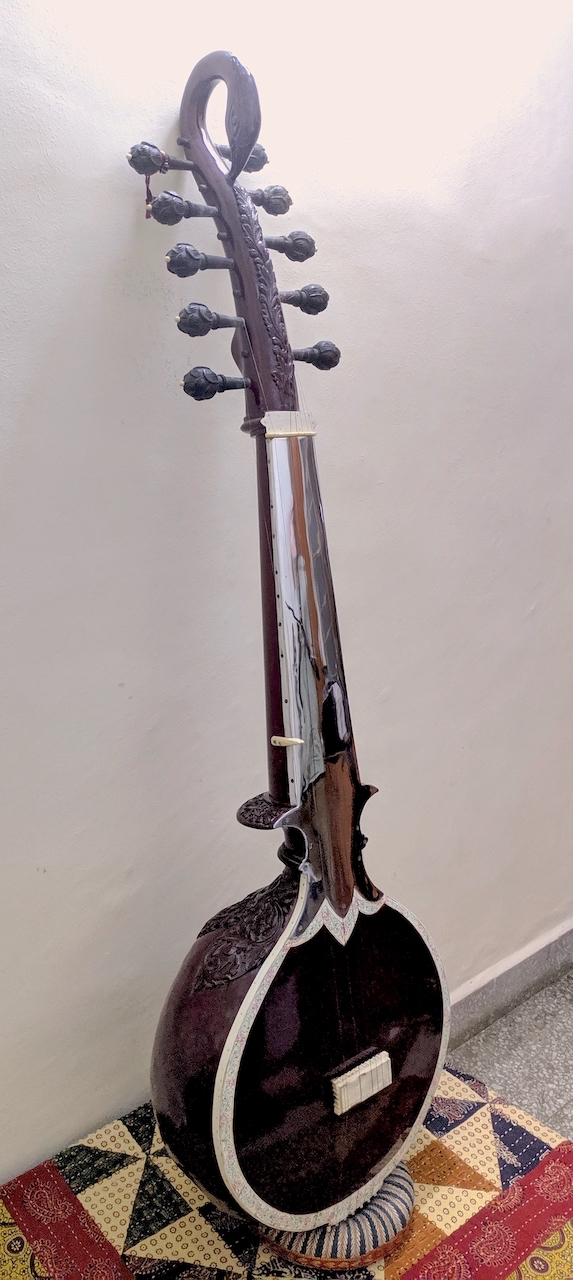The Story of Sursringar
Sursringar is an Indian musical instrument related to the more popular instrument Sarod. It is a beautiful instrument with its own unique and rich sound. There was a time when it was quite popular and was used for playing Raga Alapana because of its sustain and expressive power. Now though, there are not many people who have heard it or even heard about it. If you find yourself curious to know more about this instrument, read on to learn its history.
Here are a couple of pictures of a recent generation Sursringar crafted by the late instrument maker, Mohan Lal Sharma of Kolkata.
A Sursringar crafted by late Mohan Lal Sharma (Images courtesy of S. Balachander)
Stories and anecdotes about music and musical instruments can be an interesting mix of history and fantasy. With India's strong history of oral tradition, and an aversion to written documentation, much of the information has been carried down the generations by word of mouth. Some stories have survived, but many are lost and others have been reinterpreted with added spices!
One such story regarding the evolution of Sursringar goes as follows. But before we embark on the story of Sursringar, it is necessary to get acquainted to some related instruments from the story - Rabab and Veena.
Rabab
Rabab has been a very popular instrument of the Afghan region for many centuries. Influenced by Persian music, Rabab was often played by Pashtun/Pathan musicians of the Afghan region. The migration of Rabab happened through horse traders and military conquests. Central Asian horses were highly prized, both in military and for personal purposes. It is highly likely that Rabab came to India during the conquest of Babar, along with the military troops and horse traders.
What is a Rabab?
Rabab is a short necked lute. A Lute is a plucked string musical instrument. It typically is made of wood, has a hollow rounded resonator with a neck or fret-board attached to it, and a sound board covering it. Rababs were carved out of a single block of wood, with a resonator covered with skin, a wooden fretboard, gut strings and 3-4 gut frets. The acoustics of gut strings paired with the wooden fretboard and a hide cover didn't give much sustain/resonance to the instrument, when played with the flesh of the finger tips. As a folk instrument, or to sing ballads of valour in war, this was probably sufficient. As the needs of the music evolved, Rabab too evolved, initially adding sympathetic strings (hand made copper wires) which gave extra sustain and loudness to the instrument.
It is believed that Tansen, the celebrated court musician of Akbar, further evolved this instrument to suit the style of music prevalent during his time. This new instrument was larger in size, with a bigger resonator, a deeper sound and better sustain/resonance. The early rabab came to be called Afghan Rabab or Kabuli Rabab and the latter Seni/Seniya Rabab (in honour of Tansen) or Punjab Rabab as it was used in the traditional Sikh religious singing in the region of Punjab.
Veena
In Indian music, string instruments are generically called Veena. Many different types of Veenas have been developed and still exist in India. Some of the types of veena include Tritantri Veena (3 strings), Chitra Veena (Slide Veena), Shatatantri Veena (100 strings), Kinnari Veena and Kachhapi Veena (has a resonator in the shape of a tortoise shell), among others. Arguably, one of the grandest of Veenas is the Rudra Veena.
What is a Rudra Veena?
Rudra Veena is a stick zither. A Zither is a string instrument which is typically made of wood, has a flat hollow body which acts as the resonator, and has strings running along the body. Compared to a lute, it does not have a separate rounded resonator and a neck. Rudra Veena has a long hollow round stem (made of bamboo or wood), with two large gourd (pumpkin) resonators. Strings are tied to a post on one end of the stem, and to the peg box at the other end of the stem. The gourd resonators are attached to the stem, and provides additional volume to the instrument.
Rudra Veena is considered one of the most complete instruments for Indian music, based on its ability to follow voice, and produce subtle intonations. It was a preferred instrument in the late 18th and early 19th century, since by virtue of its structure it provided a high level of sustain and resonance. This made the instrument suitable for executing long phrases, and subtle nuances of notes which was challenging on other instruments like the Seniya Rabab.
Here is some more information about the zither and the Rudra Veena.
Story of Sursringar
It is widely believed that Sursringar was invented by a Seni Rababiya (a Seni Rabab player) Jaffar Khan (1775 – 1825). His main motivation was to improve the resonance and the tonal quality of the Seni Rabab. The story goes that once Jaffar Khan and his cousin Nirmal Shah had to demonstrate their skill on seniya rabab and veena (quite likely, the Rudra Veena) respectively at the court of Benaras. Now, bear in mind that the rabab’s sound box was covered in hide, and its strings were mostly made from catguts. Guts are not great for resonance and the instrument as a whole exhibited extreme sensitivity to weather in general and humidity or dampness in particular. You can imagine Jaffar Khan's predicament given their performance was slated to have happened during the monsoon season. After the excellent first performance by Nirmal Shah on the Veena, Jaffar Khan felt disadvantaged in front of the veena due to the limitations of his rabab. He sought a month’s time from the Maharaja of Benaras, promising to play at the end of it. It is said that during this period, Jaffar Khan, stayed with an instrument maker, and evolved a new instrument based on rabab which we now know as the Sursringar.
Some of the fundamental changes Jaffar Khan made, were the fixing of a metal plate to the whole surface of the finger board, the use of metal/wire strings in place of gut strings, the replacement of a wooden resonator with a gourd (possibly inspired by the gourd resonators of Veena), and importantly, replacement of hide cover with a wooden soundboard. The metal plate and wire strings along with wooden soundboard gave clarity, sustain and stability to Sursringar, which allowed the player the ability to execute long phrases. Another interesting fact here is that though Nirmal Shah and Jaffer Khan are portrayed as competitors, they were both descendants of Tansen! Nirmal Shah was a descendent of Tansen from his daughter's lineage, and Jaffer Khan from the son's. Nothing like a bit of family rivalry to create musical innovations!
Now that’s history. Or legend! Whatever may be the story behind its evolution, in the end, the Sursringar is one of the most charming and beautiful instruments, full of resonance, depth and beauty.
If you are a musician or music student interested in procuring a Sursringar and learning to play the instrument, get in touch by emailing bala.chander@sadharani.com.
Revive Sursringar

